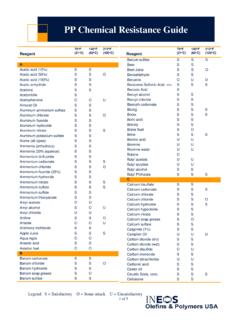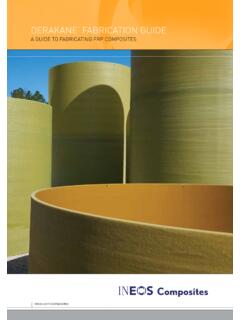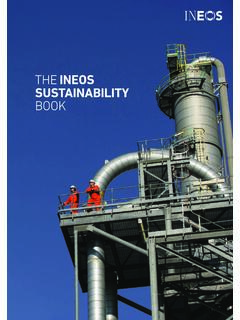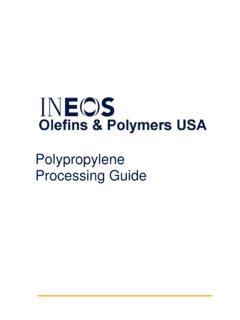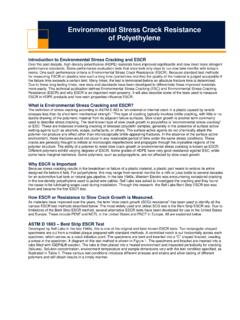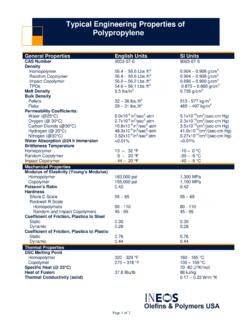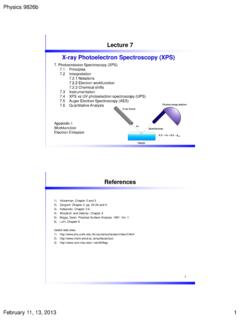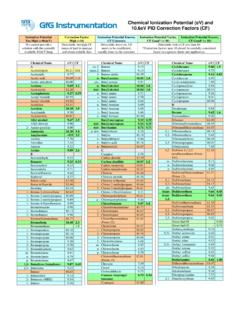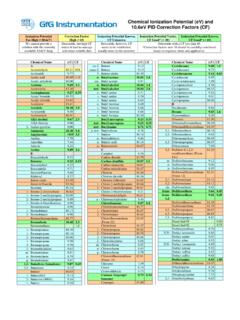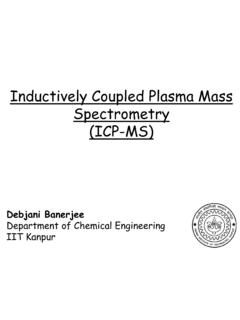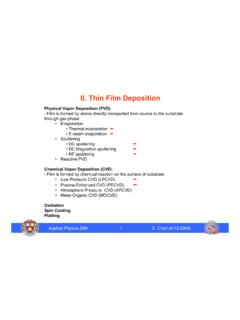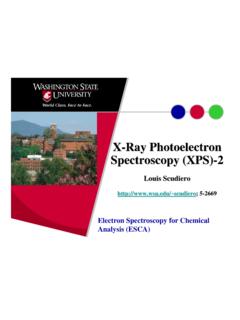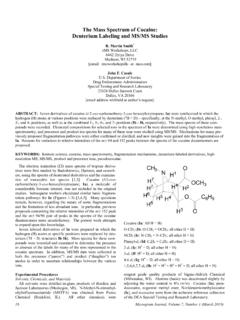Transcription of Acrylonitrile - Ineos
1 AcrylonitrileSafe Storage and Handling GuideIntroduction , chemical and thermodynamic properties and transport safety safety and health response and first aid response and environmental protection of ContentsThis booklet was prepared for individuals who handle or may come in contact with Acrylonitrile . It is a compilation of practical, understandable information designed to guide the reader in responsible handling of Acrylonitrile , and to answer commonly raised questions about Acrylonitrile safety. Before handling, always consult a current Material Safety Data Sheet (MSDS), available from Ineos , for information on the chemical. For more complete or detailed information, call the following numbers in the :Emergency Notification Number 877-856-3682 Non-Emergency Information Numer 866-363-2454 Information contained in this booklet is not intended to replace any legal requirements for Acrylonitrile handling and storage.
2 Supplemental or more detailed specifications may be necessary for individual application of this material. Information for this booklet was gathered from a selection of widely-recognized chemical industry publications. Ineos makes no representation as to the accuracy of applicability of such information in any specific the ChemicalAcrylonitrile is a clear, colorless liquid with a slightly pungent odor. It is also a hazardous chemical substance and regulated as such throughout most of the world. However, its hazards and properties are well understood. When appropriate safety procedures are in place, and employees follow those procedures, no excessive danger from the chemical exists. It is essential, however, that employees and affected individuals remain aware and informed.
3 Some of the primary hazards include reactivity, polymerization, fire and toxicity. Acrylonitrile is reactive with, and must be kept away from, strong oxidizers, especially bromine. Use extreme care to keep Acrylonitrile away from strong bases, strong acids, copper, copper alloys, ammonia and amines. Contact with these chemicals can cause a chemical reaction resulting in a fire or explosion. Chemical compatibility should also be determined before Acrylonitrile comes in contact with any other chemical. Since pure Acrylonitrile may self-polymerize, causing rapid build-up of pressure and resulting in an explosion hazard, Innovene adds inhibitor prior to shipment. This additive inhibits self-polymerization, but does not eliminate all possibility of polymerization.
4 Fires involving Acrylonitrile can release toxic gases such as hydrogen cyanide, oxides of nitrogen or carbon monoxide. Its vapors can easily form explosive mixtures in air. Since these vapors are heavier than air, they can also travel along the ground and be ignited by open flames or sparks which are some distance from the site of release. The vapors of Acrylonitrile , if inhaled at certain concentra-tions, can produce serious acute (short-term) toxicity, including loss of consciousness or death. The duration of exposure is also a factor, as is the contact of Acrylonitrile liquid or vapor with the skin. However, if administered effectively, commercially available antidotes can preclude serious harm. Additionally, long term exposure to Acrylonitrile has been shown to cause cancer in laboratory the CompanyINEOS is the world s largest producer and marketer ofAcrylonitrile, a component, or chemical intermediate, used in the manufacture of acrylic fibers, plastics, synthetic rubber and many other products.
5 The one-step, fluid bed Acrylonitrile manufacturing process was developed by scientists of The Standard Oil Company (Sohio), one of Ineos s predecessors in the in the 1950s. Today, over 95 percent of the world s Acrylonitrile is manufactured using Ineos s exclusive technology. Ineos offices are located in the Houston, Texas area with research facilities located near Chicago, 1: is a clear, colorless liquid with a slightly pungent odor. The international designation for Acryloni-trile is CAS No. 107-13-1, assigned by the Chemical Abstracts Service. The chemical structure of Acrylonitrile is: CH2=CH-CNAmmoxidation ProcessAcrylonitrile is manufactured by combining propylene, ammonia, and air in a process called ammoxidation. During ammoxidation, propylene, ammonia and air are fed through a catalyst at a high temperature.
6 The vessel containing the chemical reaction is called a fluid bed reactor, where the powdered catalyst moves fluid-like throughout the reactor. This provides a large catalyst surface area for maximum exposure to the by-products, or co-products, from the ammoxida-tion reaction include Acetonitrile (CH3CN), which is used as an industrial and laboratory solvent in the production of insulin and antibiotics, and as a raw material in the production of naturally-occurring pesticides. Another coproduct, hydrogen cyanide (HCN), is used in the manufacture of polyamides, methyl methacrylate, amino acids, chelating agents and other industrial PropertiesThe physical properties of Acrylonitrile determine its behavior under normal use conditions. Important physical property data are listed in Table For information on product specifications, please contact your Ineos representative or consult your supply 2: Physical, Chemical and Thermodynamic Acrylonitrile processReactorAbsorberAcrylonitrilerecov erycolumnLightscolumnAcrylonitrilerecove rycolumnProductcolumnOff-gasH2 OCrude acrylonitrileCrudeacetonitrileProductace tonitrileHCNH eavyimpuritiesRecycleWaste SteamAirAmmoniaPropyleneBoiler FeedWaterTable Physical properties of AcrylonitrilePropertyVa lue/UnitsCommentsReferenceMolecular g/mLat 20 C see Figure C8 Boiling point7 7.
7 3 0 Cat 760 mm Hg4 Refractive index nm, at 25 C1 Solubility in weight %at 20 C see Figure of water in weight %at 20 centipoiseat C1 Dielectric constant38at MHz4 Dipole Debyeneat, vapor5,9 Vapor ; air = 13 Critical x 104 mm Hg1 Critical C1 Critical mL/g2 Surface dynes/cmat dynes/cmat dynes/cmat CIonization eVby electron impact6 Heat of combustion (liq) kcal/mole1 Flammability limits in air volume %at 25 C12 volume %at 25 CFree energy of formation, G f, kcal/moleat 25 C3 Enthalpy of formation, H f, kcal/moleat 25 C10 Enthalpy of formation, H f, kcal/moleat 25 C10 Enthalpy of vaporization, H f, kcal/moleat 25 C1 Heat of kcal/mole11 Molar heat capacity, cal/mole K4 Molar heat capacity, cal/mole K50 C, 1 atm3 Molar heat of kcal/mole3 Entropy, kcal/mole Kat 25 C, 1 atm3 Autoignition temperature481 Cin air1 Flash point0 Ctag.
8 Open cup2 Thermal conductivity397 cal/cm sec Cat 23 C see Figure 2: Physical, Chemical and Thermodynamic illustrates how the density, or specific gravity,of Acrylonitrile varies with : Acrylonitrile liquid densityFigure summarizes the variation of the vapor pressure of Acrylonitrile with temperature. Density and vapor pressure are important properties in efficient distillation of : Acrylonitrile vapor pressureChemical PropertiesThe presence of both the olefinic (carbon-carbon double bond) group and the nitrile (cyano) group in Acrylonitrile gives the molecule its unique and varied reactivity. This reactivity leads to the great versatility of Acrylonitrile as a raw material. The olefinic group can undergo polymeriza-tion and co-polymerization, hydrogenation, oxidation, addition and cyclization.
9 The nitrile group can undergo hydrogenation, hydrolysis, hydration, esterification, cyclization and StabilityAcrylonitrile is stabilized against polymerization in storage by adding water ( to weight %) and the inhibitor methylhydroquinone (MeHQ, 35-45 ppm). Keeping the pH within the specified range and controlling the concen-trations of iron, copper and peroxides also contribute to product PropertiesTable lists thermodynamic properties of play an important role in storage, handling, transport and is flammable because it is a volatile organic chemical. Properties of flammability are defined by: flash point the temperature at which the vapor above a liquid is ignitable when mixed with air. autoignition temperature the temperature above which a vapor mixture and air can ignite without a spark or other source of ignition.
10 Heat of combustion the measure of the amount of heat given off when Acrylonitrile burns completely, forming nitrogen, carbon dioxide and values for above properties are listed in Table mixtures of Acrylonitrile and air containing between 3 and 17 percent Acrylonitrile are potentially flammable (see flammability limits in Table ) This flammability envelope is a function of temperature, pressure and the concentration of oxygen in the vapor. A representative graph showing the flammability envelope for Acrylonitrile at 32 C is shown in Figure : Reference 14 Source: Reference 15 Figure : Flammability limits of Acrylonitrile in oxygen-nitrogen mixtures. Temperature = 32 CVapor combinations of Acrylonitrile and air which fall inside the nose-shaped region on the graph are potentially flammable.

